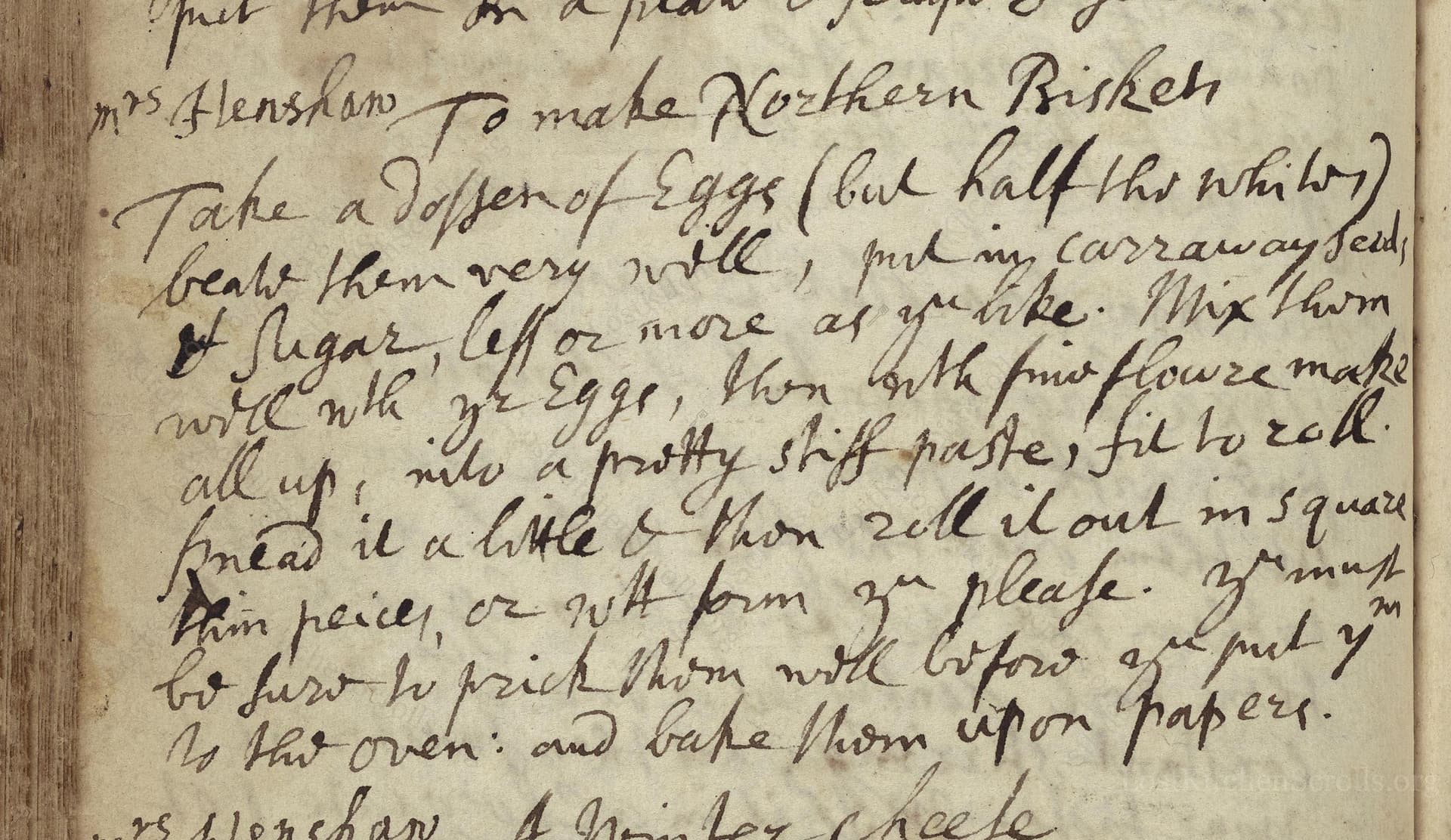Mrs Henshaw To Make Northern Bisket
From the treasured pages of Receipt book of Penelope Jephson
Written by Penelope Patrick

Mrs Henshaw To Make Northern Bisket
"Take a Dossen of Eggs (but half the whites) beate them very well, put in carraway seeds & Sugar, less or more as you like. Mix them well with yr Eggs, then with fine floure make all up, into a pretty stiff paste, fit to roll. knead it a little & then roll it out in square thin peices, or with form you please. You must be sure to prick them well before you put them to the oven: and bake them upon papers."
Note on the Original Text
The recipe is characteristically terse and presumes familiarity with kitchen techniques—hence little detail about times or quantities (quantity of flour is 'make all up into a pretty stiff paste'). Capitalization and spelling are inconsistent ('Dossen' for 'dozen', 'yr' for 'your'), which was typical of the period before spelling was standardized. Instructions are often sequenced as a stream of action, with ingredients sometimes mentioned in passing. The expectation was that readers knew basic culinary skills, so processing details (whisking, kneading, pricking) are implied with minimal explanation.

Title
Receipt book of Penelope Jephson (1673)
You can also click the book image above to peruse the original tome
Writer
Penelope Patrick
Era
1673
Publisher
Unknown
Background
Step back into the sumptuous kitchens of the late 17th century with Penelope Patrick’s culinary collection—a feast of historic recipes, secret tips, and the irresistible flavors of Restoration England all bound together in a handwritten treasure.
Kindly made available by
Folger Shakespeare Library
This recipe comes from the late 17th century, attributed to Penelope Patrick (1646–1725), and would have been prepared in England, most likely in a well-off household. Northern Bisket refers to a type of sweet, spiced biscuit (or cookie) popular in the north of England, often flavored with caraway, a beloved spice of the era. Baking such biscuits reflected both the increasing availability of sugar and refined flour, as well as the influence of trade on English home kitchens. Recipes like this were exchanged among gentlewomen, recorded by hand in personal recipe books, as shown by Mrs. Henshaw’s attribution.

Cooks of the time would have beaten eggs using a large wooden spoon or whisk. The dough would be mixed in a ceramic or wooden bowl and kneaded on a board. For rolling, a wooden rolling pin was used, and the dough was cut with a knife or shaped with simple hand-formed cutters. Biscuits were often baked in a large, wood-fired oven. Sheets of paper (rag paper or parchment) were laid on metal or stone baking sheets to prevent sticking, as non-stick pans were centuries away. Forks or special pricking tools kept the dough from bubbling up.
Prep Time
30 mins
Cook Time
15 mins
Servings
24
We've done our best to adapt this historical recipe for modern kitchens, but some details may still need refinement. We warmly welcome feedback from fellow cooks and culinary historians — your insights support the entire community!
Ingredients
- 12 large eggs (use only 12 yolks and 6 whites)
- 1–2 teaspoons caraway seeds
- 1/2–3/4 cup granulated sugar (to taste)
- 2 3/4–3 1/4 cups plain (all-purpose) wheat flour
- Extra flour for dusting
- Parchment paper (to bake on)
Instructions
- Begin by separating a dozen eggs, using only half of the whites (so 12 yolks and 6 whites).
- Beat these together until well combined and a bit frothy.
- Stir in caraway seeds (to taste, but about 1–2 teaspoons is traditional) and sugar—sweeten as you prefer, but around 1/2–3/4 cup will capture a historic sweetness.
- Gradually sift in fine wheat flour, enough to make a stiff but workable dough: expect about 2 3/4–3 1/4 cups.
- Knead the mixture just until smooth, then roll the dough out thinly on a lightly floured surface.
- Cut into squares or any desired shape.
- Prick each biscuit well with a fork to prevent puffing.
- Lay the biscuits onto parchment-lined baking trays and bake in a preheated oven at 350°F (180°C) until pale golden and firm, about 10–15 minutes.
- Cool on a rack before serving.
Estimated Calories
120 per serving
Cooking Estimates
Preparing the dough and shaping the biscuits takes about 30 minutes. Baking them in the oven will take another 10–15 minutes. Each biscuit serving has about 120 calories, and this recipe makes about 24 biscuits.
As noted above, we have made our best effort to translate and adapt this historical recipe for modern kitchens, taking into account ingredients nowadays, cooking techniques, measurements, and so on. However, historical recipes often contain assumptions that require interpretation.
We'd love for anyone to help improve these adaptations. Community contributions are highly welcome. If you have suggestions, corrections, or cooking tips based on your experience with this recipe, please share them below.
Join the Discussion
Rate This Recipe
Dietary Preference
Main Ingredients
Culinary Technique
Occasions

Den Bockfisch In Einer Fleisch Suppen Zu Kochen
This recipe hails from a German manuscript cookbook compiled in 1696, a time whe...

Die Grieß Nudlen Zumachen
This recipe comes from a rather mysterious manuscript cookbook, penned anonymous...

Ein Boudain
This recipe comes from an anonymous German-language manuscript cookbook from 169...

Ein Gesaltzen Citroni
This recipe, dating from 1696, comes from an extensive anonymous German cookbook...
Browse our complete collection of time-honored recipes



